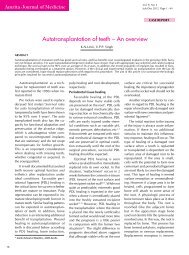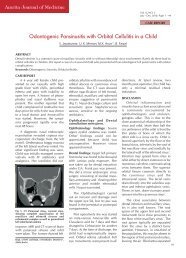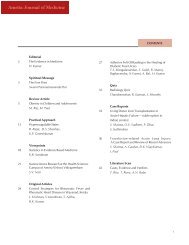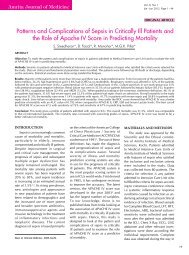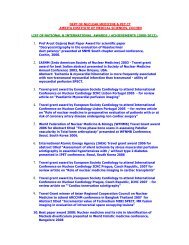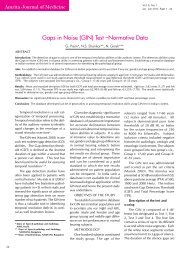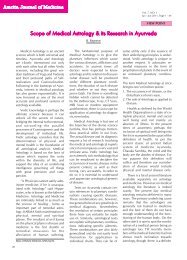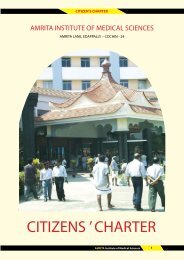Journal of Medicine Vol 4 - Amrita Institute of Medical Sciences and ...
Journal of Medicine Vol 4 - Amrita Institute of Medical Sciences and ...
Journal of Medicine Vol 4 - Amrita Institute of Medical Sciences and ...
You also want an ePaper? Increase the reach of your titles
YUMPU automatically turns print PDFs into web optimized ePapers that Google loves.
<strong>Amrita</strong> <strong>Journal</strong> <strong>of</strong> <strong>Medicine</strong><br />
Extended Maxillectomy by Transm<strong>and</strong>ibular Approach<br />
(Fig.1, Fig.2), compartmental resection <strong>of</strong> the infratemporal<br />
fossa is required to obtain for an oncologically sound<br />
resection. This is difficult to obtain using the st<strong>and</strong>ard<br />
anterior approaches using Weber-Ferguson or facial degloving<br />
incisions 4,5 . M<strong>and</strong>ibulotomy approach is a<br />
well-established technique to approach infratemporal<br />
fossa 6 . Herein we report effectiveness in performing extended<br />
maxillectomy with infra-temporal fossa clearance<br />
using m<strong>and</strong>ibulotomy approach.<br />
OBJECTIVE<br />
The objective <strong>of</strong> this study was to describe the technique<br />
<strong>of</strong> m<strong>and</strong>ibulotomy approach for excision <strong>of</strong> maxillary sinus<br />
tumor with extension to the infratemporal fossa as<br />
well as to evaluate the effectiveness <strong>and</strong> morbidity associated<br />
with the procedure.<br />
MATERIALS AND METHODS<br />
Head <strong>and</strong> neck oncology database <strong>of</strong> <strong>Amrita</strong> <strong>Institute</strong> <strong>of</strong><br />
<strong>Medical</strong> Science was reviewed to identify all patients who<br />
have undergone maxillectomy during three-year period<br />
from January 2004 to January 2007. Reviewing <strong>of</strong> the<br />
patient records identified those patients who have undergone<br />
maxillectomy with m<strong>and</strong>ibulotomy approach.<br />
Patient demographics, treatment details <strong>and</strong> follow up<br />
disease status were obtained from the patient records.<br />
The preoperative imaging studies were reviewed to assess<br />
the extent <strong>of</strong> tumour. The surgical resection margin was<br />
recorded from the histopathological report. The patients<br />
were recalled to assess morbidity pr<strong>of</strong>ile using a pre-defined<br />
data sheet. The data point included- patient<br />
complaints, facial scar, complication at the<br />
m<strong>and</strong>ibulotomy site, occlusal disturbances, mouth opening<br />
<strong>and</strong> disease status.<br />
SURGICAL TECHNIQUE<br />
A midline lip-splitting incision, which was extended to<br />
the neck, was utilized for the procedure (Fig.3). Intraorally,<br />
the mucosal incision from the lower lip was<br />
extended to the alveolus <strong>and</strong> then to the ipsilateral premolar<br />
region as an inter-dental incision. After pre-adapting<br />
bone plates, a para-median m<strong>and</strong>ibulotomy was performed<br />
at the premolar <strong>and</strong> canine inter-dental area. Care<br />
is taken to identify <strong>and</strong> preserve the mental nerve. The<br />
inter-dental incision was then extended posteriorly on<br />
the medial side <strong>of</strong> m<strong>and</strong>ible to the retro molar region in<br />
Fig.4: Intra-oral incision extended to the upper gingivobuccal<br />
sulcus anteriorly upto the proposed site <strong>of</strong> palatal<br />
cut. Medial Pterygoid plate divided at its insertion<br />
a sub-periosteal plane. The incision was extended to the<br />
upper gingivo-buccal sulcus <strong>and</strong> then anteriorly till the<br />
intended site <strong>of</strong> palatal incision (Fig.4).<br />
Fig.5: Vessel loop around the lingual nerve <strong>and</strong> the metal<br />
instrument pointing at the inferior alveolar nerve<br />
Fig.3: Midline lip-split incision extending into the neck<br />
The s<strong>of</strong>t tissues are elevated <strong>of</strong>f the medial side <strong>of</strong> m<strong>and</strong>ible<br />
in a sub-periosteal plane; the medial pterygoid is<br />
divided at its insertion on the m<strong>and</strong>ible (Fig.4). The inferior<br />
alveolar nerve <strong>and</strong> the lingual nerve are identified<br />
<strong>and</strong> preserved (Fig.5). Further the lateral pterygoid muscle<br />
is detached from the condyle <strong>of</strong> the m<strong>and</strong>ible. The stylom<strong>and</strong>ibular<br />
ligament <strong>and</strong> periosteal attachment at the<br />
posterior boarder <strong>of</strong> m<strong>and</strong>ible was then released. The<br />
m<strong>and</strong>ible can then be swung laterally to achieve good<br />
exposure <strong>of</strong> the infratemporal fossa <strong>and</strong> the middle cranial<br />
base. The internal maxillary artery can be visualized<br />
24



